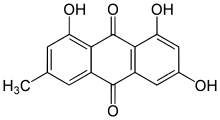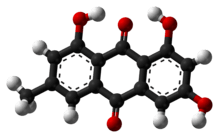Emodin
 | |
 | |
| Names | |
|---|---|
| IUPAC name
1,3,8-Trihydroxy-6-methylanthracene-9,10-dione | |
| Other names
6-Methyl-1,3,8-trihydroxyanthraquinone | |
| Identifiers | |
3D model (JSmol) |
|
| ChEBI | |
| ChEMBL | |
| ChemSpider | |
| DrugBank | |
| ECHA InfoCard | 100.007.509 |
| KEGG | |
PubChem CID |
|
| UNII | |
| |
| |
| Properties | |
| C15H10O5 | |
| Molar mass | 270.24 g·mol−1 |
| Appearance | Orange solid[1] |
| Density | 1.583±0.06 g/cm3 |
| Melting point | 256 to 257 °C (493 to 495 °F; 529 to 530 K) |
Except where otherwise noted, data are given for materials in their standard state (at 25 °C [77 °F], 100 kPa). | |
| Infobox references | |
Emodin (6-methyl-1,3,8-trihydroxyanthraquinone) is a chemical compound that can be isolated from rhubarb, buckthorn, and Japanese knotweed (Fallopia japonica syn. Polygonum cuspidatum).[2] It is also produced by many species of fungi, including members of the genera Aspergillus, Pyrenochaeta, and Pestalotiopsis, inter alia. The common name is derived from Rheum emodi (Himalayan rhubarb) and synonyms include emodol, frangula emodin, rheum emodin, 3-methyl-1,6,8-trihydroxyanthraquinone, Schuttgelb, and Persian Berry Lake.[3]
List of plant species
The following plant species produce emodin:
- Acalypha australis[4]
- Cassia occidentalis[5]
- Cassia siamea[6]
- Fallopia japonica[7] (syn. Polygonum cuspidatum[8])
- Frangula alnus[9]
- Glossostemon bruguieri [10]
- Kalimeris indica[11]
- Polygonum hypoleucum[12]
- Rhamnus alnifolia, the alderleaf buckthorn[13]
- Rhamnus cathartica, the common buckthorn[13]
- Rheum palmatum[14]
- Rumex nepalensis[15]
- Senna obtusifolia[16] (syn. Cassia obtusifolia[17])
- Thielavia subthermophila[18]
- Ventilago madraspatana[19]
Compendial status
References
- ↑ Herbal Extract Online. http://herbalextractonline.com/Herbal-Extract/Emodin.html (accessed 9 November 2014).
- ↑ Dorland's Medical Dictionary (1938)
- ↑ CID 3220 from PubChem
- ↑ Wang, X. L.; Yu, K. B.; Peng, S. L. (2008). "[Chemical constituents of aerial part of Acalypha australis]" [Chemical Constituents of Aerial Part of Acalypha australis]. Zhongguo Zhong Yao Za Zhi [China Journal of Chinese Materia Medica] (in Chinese). 33 (12): 1415–1417. PMID 18837345.
- ↑ Yadav, J. P.; Arya, V.; Yadav, S.; Panghal, M.; Kumar, S.; Dhankhar, S. (2010). "Cassia occidentalis L.: A Review on its Ethnobotany, Phytochemical and Pharmacological Profile". Fitoterapia. 81 (4): 223–230. doi:10.1016/j.fitote.2009.09.008. PMID 19796670.
- ↑ Nsonde Ntandou, G. F.; Banzouzi, J. T.; Mbatchi, B.; Elion-Itou, R. D.; Etou-Ossibi, A. W.; Ramos, S.; Benoit-Vical, F.; Abena, A. A.; Ouamba, J. M. (2010). "Analgesic and Anti-Inflammatory Effects of Cassia siamea Lam. Stem Bark Extracts". Journal of Ethnopharmacology. 127 (1): 108–111. doi:10.1016/j.jep.2009.09.040. PMID 19799981.
- ↑ http://www.ars-grin.gov/cgi-bin/duke/highchem.pl
- ↑ Ban, S. H.; Kwon, Y. R.; Pandit, S.; Lee, Y. S.; Yi, H. K.; Jeon, J. G. (2010). "Effects of a Bio-Assay Guided Fraction from Polygonum cuspidatum Root on the Viability, Acid Production and Glucosyltranferase of mutans streptococci". Fitoterapia. 81 (1): 30–34. doi:10.1016/j.fitote.2009.06.019. PMID 19616082.
- ↑ Faculty of Pharmacy and Biochemistry, University of Zagreb, A. Kovačića 1, 10000 Zagreb, Croatia b Dipartimento di Scienze del Farmaco, Università degli Studi “G. d’Annunzio” di Chieti-Pescara, Via dei Vestini 31, 66100 Chieti, Italy (April 2012). "Anthraquinone profiles, antioxidant and antimicrobial properties of Frangula rupestris (Scop.) Schur and Frangula alnus Mill. bark". Food Chemistry. 131: 1174–1180 – via Elseiver Science Direct.
- ↑ http://www.mdpi.net/molecules/papers/80800614.pdf
- ↑ Wang, G.; Wang, G. K.; Liu, J. S.; Yu, B.; Wang, F.; Liu, J. K. (2010). "[Studies on the chemical constituents of Kalimeris indica]" [Studies on the Chemical Constituents of Kalimeris indica]. Zhong Yao Cai (in Chinese). 33 (4): 551–554. PMID 20845783.
- ↑ Chao, P. M.; Kuo, Y. H.; Lin, Y. S.; Chen, C. H.; Chen, S. W.; Kuo, Y. H. (2010). "The Metabolic Benefits of Polygonum hypoleucum Ohwi in HepG2 Cells and Wistar Rats under Lipogenic Stress". Journal of Agricultural and Food Chemistry. 58 (8): 5174–5180. doi:10.1021/jf100046h. PMID 20230058.
- 1 2 Sacerdote, Allison B.; King, Richard B. (2014). "Direct Effects of an Invasive European Buckthorn Metabolite on Embryo Survival and Development in Xenopus laevis and Pseudacris triseriata" (pdf). Journal of Herpetology. 48 (1): 51–58. doi:10.1670/12-066.
- ↑ Liu, A.; Chen, H.; Wei, W.; Ye, S.; Liao, W.; Gong, J.; Jiang, Z.; Wang, L.; Lin, S. (2011). "Antiproliferative and Antimetastatic Effects of Emodin on Human Pancreatic Cancer". Oncology Reports. 26 (1): 81–89. doi:10.3892/or.2011.1257. PMID 21491088.
- ↑ Gautam, R.; Karkhile, K. V.; Bhutani, K. K.; Jachak, S. M. (2010). "Anti-Inflammatory, Cyclooxygenase (COX)-2, COX-1 Inhibitory, and Free Radical Scavenging Effects of Rumex nepalensis". Planta Medica. 76 (14): 1564–1569. doi:10.1055/s-0030-1249779. PMID 20379952.
- ↑ Dr. Duke's Phytochemical and Ethnobotanical Databases
- ↑ Yang, Y.-C.; Lim, M.-Y.; Lee, H.-S. (2003). "Emodin Isolated from Cassia obtusifolia (Leguminosae) Seed Shows Larvicidal Activity against Three Mosquito Species". Journal of Agricultural and Food Chemistry. 51 (26): 7629–7631. doi:10.1021/jf034727t. PMID 14664519.
- ↑ Kusari, S.; Zühlke, S.; Košuth, J.; Čellárová, E.; Spiteller, M. (2009). "Light-Independent Metabolomics of Endophytic Thielavia subthermophila Provides Insight into Microbial Hypericin Biosynthesis". Journal of Natural Products. 72 (10): 1825–1835. doi:10.1021/np9002977. PMID 19746917.
- ↑ Ghosh, S.; Das Sarma, M.; Patra, A.; Hazra, B. (2010). "Anti-Inflammatory and Anticancer Compounds Isolated from Ventilago madraspatana Gaertn., Rubia cordifolia Linn. and Lantana camara Linn". Journal of Pharmacy & Pharmacology. 62 (9): 1158–1166. doi:10.1111/j.2042-7158.2010.01151.x. PMID 20796195.
- ↑ The British Pharmacopoeia Secretariat (2009). "Index, BP 2009" (PDF). Archived from the original (PDF) on 11 April 2009. Retrieved 20 April 2010.
This article is issued from
Wikipedia.
The text is licensed under Creative Commons - Attribution - Sharealike.
Additional terms may apply for the media files.